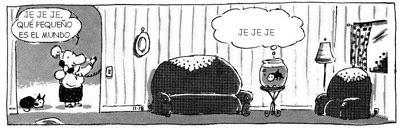"Zits: s. espinilla, comedón. Grano sebáceo con un punto negro que sale en la cara"

¿De qué va? Humor (tira de prensa). Zits narra la vida diaria de Jeremy Duncan, un chico de 15 años. A través de él asistiremos a su relación con sus padres, su afición por un ruidoso grupo de música que su madre no soporta, su primera novia, su amistad con su mejor amigo... en definitiva, refleja una de las etapas más importantes y difíciles en la vida de una persona: la adolescencia.

Characters Jere my.
my. You are, unfortunately, 15 years old. A high school freshman with, thank God, four good friends, but other than that a seriously boring life in a seriously boring town made livable only by the knowledge that someday in the far-off future at least this will all be over and you’ll turn 16 and get a driver’s license which you so richly deserve and then life will finally be good. Oh, and your parents are seriously ruining your life.
 Connie. You’re 43, probably look it in the jowls, you touch up the gray occasionally, but are a reasonably fit person with a good marriage and a healthy family. With Jeremy finally in high school, you’ve found the time to start scratching that creative itch for writing a book you’ve had for the last ten years… and it’s going surprisingly well! After 16 short months, you’re already three-quarters of the way through chapter one! Of course, you would be further along if Jeremy would just get it through his thick head that the sign you hang on the spare bedroom door says “Do Not Disturb”, and not “Please Interrupt Me So I Can Drive You Someplace That You Could Easily Have Walked To By Now”.
Connie. You’re 43, probably look it in the jowls, you touch up the gray occasionally, but are a reasonably fit person with a good marriage and a healthy family. With Jeremy finally in high school, you’ve found the time to start scratching that creative itch for writing a book you’ve had for the last ten years… and it’s going surprisingly well! After 16 short months, you’re already three-quarters of the way through chapter one! Of course, you would be further along if Jeremy would just get it through his thick head that the sign you hang on the spare bedroom door says “Do Not Disturb”, and not “Please Interrupt Me So I Can Drive You Someplace That You Could Easily Have Walked To By Now”.
Walt(Prolonged sigh) ...
 The boy is, quite honestly, a handful at times. Jeremy seems to brood a lot. That concerns you, but, hey, hormones can explain plenty of odd behavior. Nobody would know that better than an orthodontist who, by profession, is sentenced to spending nearly eight hours of every day staring directly into the jaws of puberty. It’s weird. You pride yourself on your ability to listen to and communicate with patients, but when it comes to your own son, you practically have to pry every syllable out of him.
The boy is, quite honestly, a handful at times. Jeremy seems to brood a lot. That concerns you, but, hey, hormones can explain plenty of odd behavior. Nobody would know that better than an orthodontist who, by profession, is sentenced to spending nearly eight hours of every day staring directly into the jaws of puberty. It’s weird. You pride yourself on your ability to listen to and communicate with patients, but when it comes to your own son, you practically have to pry every syllable out of him.
 Pierce was brought in to replace the former drummer,Y.A. in Jeremy’s band. He prides himself on his appearance and has everything a garage band drummer needs... danger, mystery, energy, a hot girlfriend and partially deaf parents. He wears a constant scowl on his face, which is understandable for someone with three pounds of jewelry on his head.
Pierce was brought in to replace the former drummer,Y.A. in Jeremy’s band. He prides himself on his appearance and has everything a garage band drummer needs... danger, mystery, energy, a hot girlfriend and partially deaf parents. He wears a constant scowl on his face, which is understandable for someone with three pounds of jewelry on his head.
Hector Garcia. Jeremy has been your best friend since the fourth grade when  you moved here. You guys are amigos and hardly ever get on each other’s nerves much, and even when you do it’s no big deal because there’s way too much history between you to sweat the small stuff. Amigos, dude.
you moved here. You guys are amigos and hardly ever get on each other’s nerves much, and even when you do it’s no big deal because there’s way too much history between you to sweat the small stuff. Amigos, dude.
 Sara Toomey. First of all, let’s get this boyfriend / girlfriend thing straight. Jeremy is sweet and everything and he’s the only guy that you’ve ever actually wanted to shave your legs for, but the term “girlfriend” just makes your teeth grind because, let’s face it, it practically connotes ownership. Besides, you can’t name one relationship you’ve seen that truly works on the basis of total equality or that has the shelf life of, say, a ripe banana. As Dorothy Parker wrote, "Oh, life is a glorious cycle of song, A medley of extemporanea;And love is a thing that can never go wrong; And I am Marie of Roumania."
Sara Toomey. First of all, let’s get this boyfriend / girlfriend thing straight. Jeremy is sweet and everything and he’s the only guy that you’ve ever actually wanted to shave your legs for, but the term “girlfriend” just makes your teeth grind because, let’s face it, it practically connotes ownership. Besides, you can’t name one relationship you’ve seen that truly works on the basis of total equality or that has the shelf life of, say, a ripe banana. As Dorothy Parker wrote, "Oh, life is a glorious cycle of song, A medley of extemporanea;And love is a thing that can never go wrong; And I am Marie of Roumania."
 D’ijon is Pierce’s girlfriend. Although she looks more mainstream than Pierce, she shares his interest in the counterculture (she has a tattoo of Edvard Munch’s "The Scream” on her tongue). D’ijon is Sara’s best friend, loves to talk and is a compassionate, kind, fun-loving and enthusiastic personality.
D’ijon is Pierce’s girlfriend. Although she looks more mainstream than Pierce, she shares his interest in the counterculture (she has a tattoo of Edvard Munch’s "The Scream” on her tongue). D’ijon is Sara’s best friend, loves to talk and is a compassionate, kind, fun-loving and enthusiastic personality.
Sobre el cómic Zits es la primera tira cómica del dibujante Jim Borgman, que viene realizando humor gráfico para prensa desde finales de los 70, y ganó en 1991 el prestigioso Premio Pulitzer en la categoría de Periodismo Gráfico. Los guiones de la serie corren a cargo de Jerry Scott, que llevaba años realizando la exitosa tira de prensa Baby Blues. Ambos se unieron en 1997 para empezar a realizar Zits, que de salida se publicó en la cifra récord de 200 periódicos. La tira ha llegado a alcanzar fama de nivel mundial, apareciendo en más de 900 publicaciones (en España se ha publicado en el diario El País, dentro del suplemento dominical El Pequeño País con Jeremy "renombrado" como Jaime). Algunos lectores incluso consideraran a Zits la sucesora natural de Calvin y Hobbes, y aunque no llega al nivel de aquella -dificilísimo de alcanzar-, el hecho es que se ha convertido en una de las más destacadas tiras de prensa que se publican en la actualidad. En cualquier caso, como mínimo no se puede negar que guarda algunas similitudes con la obra de Watterson: Jeremy recuerda fisicamente a un Calvin crecido, y ocasionalmente su imaginación toma el protagonismo de la tira, mostrandonos la realidad "distorsionada subjetivamente" a través de los ojos de Jeremy (de manera análoga a lo que pasaba con el pequeño Calvin). Premios // Ganadora del premio de la National Cartoonist Society a la mejor tira humorística en 1998 y 1999. Ganadora de la medalla Max and Moritz a la mejor tira humorística internacional en el 2000. Recientemente el guionista Jerry Scott ha recibido por su trabajo en Zits y Baby Blues el prestigioso premio Reuben 2001 de la National Cartoonist Society (el premio más importante en EEUU dentro del campo de las tiras de prensa).
















 Pierce was brought in to replace the former drummer,Y.A. in Jeremy’s band. He prides himself on his appearance and has everything a garage band drummer needs... danger, mystery, energy, a hot girlfriend and partially deaf parents. He wears a constant scowl on his face, which is understandable for someone with three pounds of jewelry on his head.
Pierce was brought in to replace the former drummer,Y.A. in Jeremy’s band. He prides himself on his appearance and has everything a garage band drummer needs... danger, mystery, energy, a hot girlfriend and partially deaf parents. He wears a constant scowl on his face, which is understandable for someone with three pounds of jewelry on his head. 



